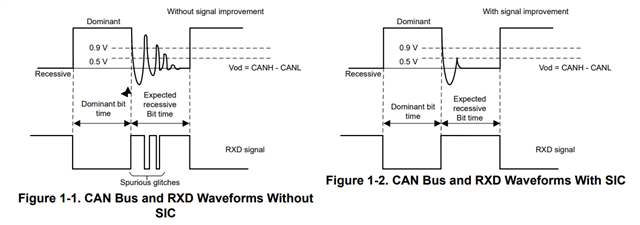Tool/software:
Hi team,
How dominant to recessive signal is improved in CAN FD SiC on TCAN1462-Q1? In addition, is there any other specific method decided in CiA or ISO standard?
https://www.ti.com/lit/wp/slla581/slla581.pdf

Regards,
Ochi
This thread has been locked.
If you have a related question, please click the "Ask a related question" button in the top right corner. The newly created question will be automatically linked to this question.
Tool/software:
Hi team,
How dominant to recessive signal is improved in CAN FD SiC on TCAN1462-Q1? In addition, is there any other specific method decided in CiA or ISO standard?
https://www.ti.com/lit/wp/slla581/slla581.pdf

Regards,
Ochi
Hi Ochi,
The method is defined in CiA 601-4, by actively driving the bus into recessive for an estimated time with a controlled 100 ohms output instead of instantly going to 60 kohms, thereby improving dominant to recessive edges.
I.e., as soon as TXD goes dominant (low) to recessive (high), the device will not immediately switch to it's very high impedance recessive output. Instead, it enters an active recessive phase for up to tSIC_TX_base = 530 ns where the output impedance is stronger, held at 100 ohms. The low impedance closely matches the bus characteristic and suppresses reflections. Hence, the bus voltage smoothly settles into the recessive window with less ringing. Please see 8.1.1 of the data sheet for more information, thanks.
Best Regards,
Michael.
Hi MIchael,
Thank you for response.
In general, is there just one method following CiA601-4? One engineer asked a question as below;
Does TCAN1462-Q1 CiA601-4 method follow "Tx mothod" or "Rx method"?
We are not sure if there is several method for CAN FD SiC and also if there is Tx method and Rx method respectively. Could we understand there is no ohter method than TCAN1462-Q1 for SiC or no sepecific method such as TX method and EX method?
We understood CiA or ISO standard has a little bit different timing parameters, but the question is related to how SiC is done functionally.
Regards,
Ochi
Hi Ochi,
Unfortunately, no. However, customers may also add passive dampening resistors on RXD (typically 33 to 100 ohms as needed). This is passively done externally while the standard is actively done internally.
Note that the receivers are passive on the bus as they simply sample CANH / CANL once the bus settles and the standard do not define active filtering or impedance shaping on the receive side I.e., you either see dominant or recessive levels once the transmitter finishes its active-recessive face.
All bus-edge improvement in CAN FD SiC comes from the transmitter holding a 100 ohm drive for up to ~530 ns when going recessive and there is no separate Rx method, and no alternate standard beyond CiA 601-4 for this functional behavior, thanks.
Best Regards,
Michael.